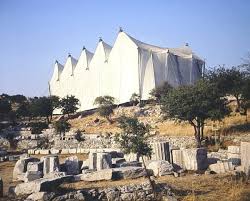Bassae Apollo Epicurius Temple – Greece

Address
Bassae Apollo Epicurius Temple- Bassae, Figaleia 270 61, Greece
Diety
Surya (Sun)
Introduction
Bassae lies near the village of Skliros, northeast of Figaleia, south of Andritsaina and west of Megalopolis. It is famous for the well-preserved mid- to late-5th century BC Temple of Apollo Epicurius. This famous temple to the god of healing and the sun was built towards the middle of the 5th century B.C. in the lonely heights of the Arcadian mountains. The temple, which has the oldest Corinthian capital yet found, combines the archaic style and the serenity of the Doric style with some daring architectural features. Although this temple is geographically remote from major polities of ancient Greece, it is one of the most studied ancient Greek temples because of its multitude of unusual features. Bassae was the first Greek site to be inscribed on the World Heritage List (1986).
Puranic Significance
The columned temple of Apollo Epicurius rises majestically within the sanctuary of Bassae in the mountains of Arkadia. It is one of the best-preserved monuments of classical antiquity and an evocative and poignant testament to classical Greek architecture. It is highly significant for its architectural features and influence. The temple was built at the height of the Greek civilization in the second half of the 5th century BC (420-400 BC). It was dedicated to Apollo Epicurius by the Phigaleians, who believed the god of sun and healing had protected them from plague and invasion. In 174 AD the ancient traveler Pausanias admired the beauty and harmony of the temple and attributed it to Iktinos, the architect of the Parthenon. The temple appears to have been forgotten for almost 1700 years until it was rediscovered in the 18th century and attracted intense interest from scholars and artists. The isolation of the site ensured many significant features survived largely intact. The temple is one of the earliest post-Parthenonian edifices and the earliest monument in which all three ancient Greek architectural orders – Doric, Ionic and Corinthian – are found together. It also included the earliest surviving Corinthian column capital. The temple further exhibits a number of bold and innovative architectural designs that mark a turning point in the development of temple-building. Through a series of ingenious devices, the architect successfully balanced contrasting elements and blended the old with the new, contributing to the unique architectural and artistic value of the monument. The temple, as well as its sculptural decoration consist one of the best-preserved samples of the ancient Greek civilization, from the period of its heyday (5th century BC). All the significant elements of the temple, such as its outer colonnade, as well as many features of the internal architecture arrangement, are preserved largely intact. The long distance of the property from settlements has ensured a high degree of authenticity. The site was forgotten for 1700 years ensuring that there were no significant modifications to the structure after its completion in the 5th century. As a consequence the structure and almost all of its building material has been preserved and the temple is one of the most authentic from this period.
Century/Period/Age
5th century BC (420-400 BC).
Managed By
UNESCO World Heritage Site.
Nearest Bus Station
Figaleia
Nearest Railway Station
Palaiofarsalos
Nearest Airport
Kalamata









